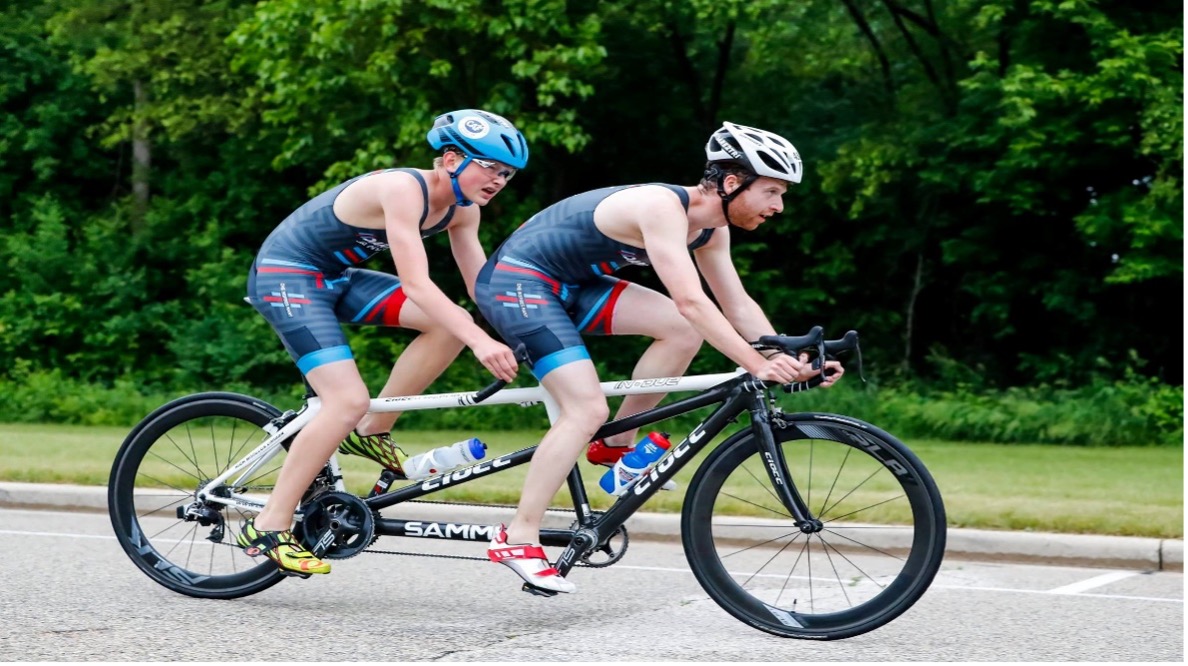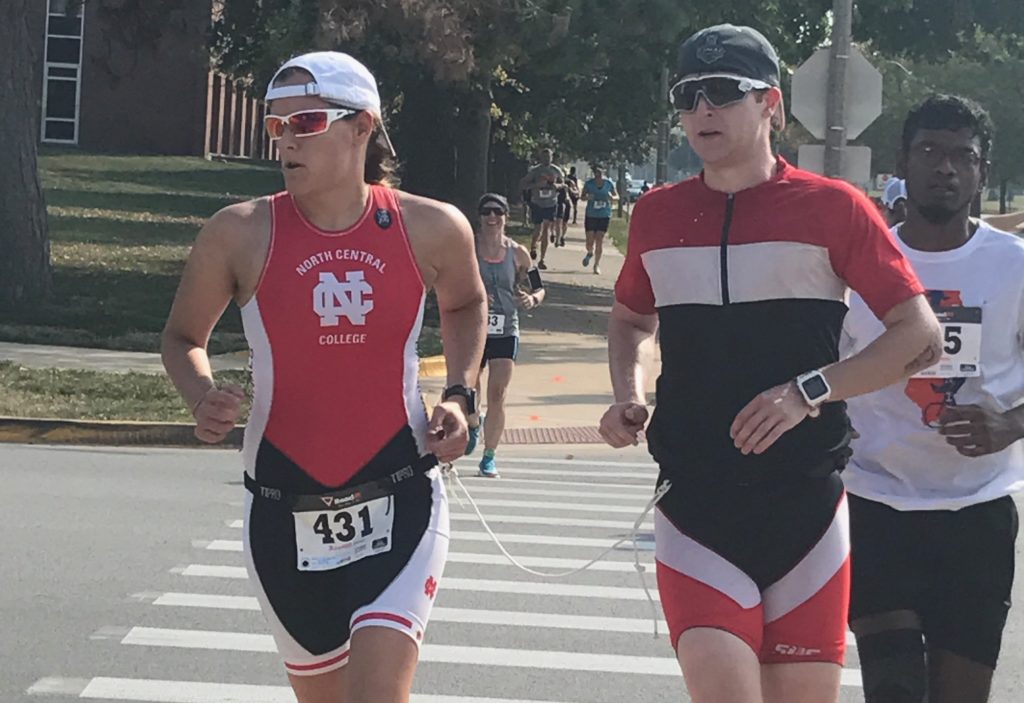
Q: In addition to your own triathlon racing, we understand you guide blind or visually impaired competitors so they can have their own victory at the finish line. Tell us how you got involved and what organization you work with.
A: I was racing the 2014 North Shore Triathlon and got passed by a pair of athletes on a tandem bicycle. I later learned that they were a team of a blind athlete and guide from Dare2tri- a Paratriathlon program based in Chicago. I decided to look up the organization, began volunteering at practices, and eventually learned how to guide visually impaired athletes.
Q. How many races have you helped guide your competitors, and what where they (location and distance)?
A.: Most of the paratriathlons I have guided are at the sprint distance. I have also guided 5k and 10k runs. I have guided local races around the Midwest including Leon’s Triathlon, the Leaning Tower Sprint, and the Pleasant Prairie Triathlon. I also guided a few races with the North Central College Triathlon Team, one of whose athletes has a visual impairment. This fall, I guided my first ITU (International Triathlon Union) Race in Sarasota Florida, racing in a Team USA uniform.
Q: In your experience, what tends to be the toughest for your competitors as it concerns the three legs of the triathlon and why?
A: Most signaling, and information exchange is done verbally. As such, the swim is often the most difficult leg for visually impaired athletes, as we lose the ability to speak to one another. Athletes and guides employ several tactile signals such as tapping shoulders to communicate turns and hazards on the swim course.
Q: How do you train for to help your competitors? Does the organization you work with provide any specialized training? For instance, do you have to get use to a tandem bike with your athlete?
A: Guiding visually impaired athletes has its own unique set of skills, which requires training and practice. Dare2tri provides a number of “Learn to Guide” clinics where athletes can learn to pilot tandems with visually impaired athletes. We also have several weekend long camps where athletes and guides are paired together for a full weekend of training and racing. This allows a guide-athlete team to train and practice together and develop their skills as a pair. The strongest guide-athlete pairings have developed considerable chemistry over many years of training and racing together.
Q: How does the pairing happen… i.e. are guides such as yourself paired with athletes based on size, age and ability?
A: Organizations like Dare2tri can help to ease the process of athletes finding a guide. Athletes can contact the organization if they are planning on competing in a race or attending a camp and request a guide. The athlete will provide information about their experience, skill set, style of racing, and paces. The organization will help find a guide who meets these needs and put the two in contact. Athletes will often retain contact information for guides with whom they have had positive experiences and can contact them directly for future races.
Q. How about pre-race prep, what considerations are considered, i.e., tether adjusting to a manageable length (too short and rhythm could be disrupted, etc.), shoelaces tied, number of steps counted from the water to bike transition, etc.?
A: One of the most important considerations is how transition is set up. With the guide’s help, the athlete will set up transition so that each item is exactly where they want it to be. The guide’s job is to make sure they are aware of how it is set up, where each piece of gear is in relation to the others, and in relation to where the athlete will be standing during transition. The transition also is usually done according to a pre-agreed-upon “choreography.” For example, both the guide and athlete will mount the tandem from the same side and must begin pedaling with the same foot at the same time. The guide and athlete will practice these motions in the same way several times so that on race day they can be executed quickly and safely.
Q. How are you connected to your competitor during the swim and the run?
A: During the swim, the guide and athlete are connected via an elastic tether. This tether provides signaling as to the proper direction to swim. For example, if the athlete is swimming away from the guide, they will feel tension on the tether and will know to adjust their directions. This tether is typically attached either to the waist or quadriceps of both athletes.
For the run, athletes will use different tethers based on individual needs and preference. Many athletes will use a tether that is held in the hand of each runner. This provides immediate and direct signaling from the guides. Some athletes prefer to use a tether wrapped around the waist so that they can swing their arms freely while they run. This makes signaling slightly less immediate, so verbal communication is important. Athletes who use this method tend to have slightly better vision (can see shapes or have some peripheral vision) or have very good awareness of their body in space.

Q: Who establishes the pace, and when is that decided, i.e., do you train with specific pacing in mind for each leg of the triathlon?
A: Pacing is at the discretion of the athlete during all legs of the race. The guide’s job is to facilitate the athlete meeting that pace while providing them as much information as necessary to race safely. Thus, it is ideal for the guide to be able to race faster times than the athlete that they are guiding. This ensures that even when the athlete is racing as hard as they can, the guide can provide information verbally and be aware of and able to avoid hazards. This fact has been a major source of accountability for me in my training and was the reason I came to Precision in the first place. Many of the athletes I have guided in the past have continued to train and get stronger and stronger. To keep guiding these athletes in the future, I must keep improving as well. It gives me plenty of motivation to kick myself out of bed those early morning trainer rides.
Q: Understandably, you as a guide need to be in top triathlon shape to be able to race with the athlete and adapt to conflicts that almost always arise…what are some of the conflicts you and your competitor had to overcome during events?
A: Last year, I raced the Capitol View Sprint Triathlon in Madison, Wisconsin, with the North Central College Triathlon Team. The athlete I was guiding was in the final race of her senior year, and we wanted to send her out on a high note. The weather had other ideas, however, and it quickly became a very tough day. It rained all day and the air temperature was around 40 degrees, with Madison’s hilly roads becoming very slick and the wind stinging the two of us on every descent. I remember seeing ambulances picking up age group athletes who had wrecked on the wet roads. Negotiating a heavy tandem down these descents proved difficult, and as the race progressed, I noticed that my hands were getting more and more numb from the cold, making shifting and braking difficult. As a team, we resolved to climb as aggressively as we could, pushing hard on the uphill and then making sure the downhills were taken as safely as possible. We also had planned on pulling our feet out of our shoes before the dismount to transition as quickly as possible. However, both I and the athlete I was guiding were suffering from numb hands and feet and decided that it would be too risky to attempt this difficult maneuver. Despite the suffering and adjustments we made, we fought through a tough off-road run and survived to the finish. Sometimes racing is about setting a personal best, sometimes it’s just about survival.
Q. I would imagine the run involves near-continual dialogue. What form does this take, for example alerts about the next turn, hill, pep talk, or even keeping count of very person you have passed.
A: My job as a guide is first and foremost to provide my athlete with as much information as possible. For example, when approaching a turn on the bike, I will let the athlete know which way we are turning, how sharp the turn is, whether we need to reduce speed or can keep pedaling, and whether we need to adjust gearing. I will also provide a countdown to the moment at which I will be turning the handlebars (3…2…..1….turn) so that the stoker and I can shift our bodyweight in unison, allowing for the tandem to make the turn more easily. On the run, I will be providing information about turns and hazards. For example, if we need to duck under a low branch, or step over a curb or crack in the road, I will provide the necessary information so that we can do so. I will also let the athlete know if we need to step around other runners. Guides can also provide information about pacing, distance and time, which can be especially helpful if an athlete has target paces that they are trying to hit on the bike and run. The guide can also, if necessary, be there as an emotional support, keeping the athlete motivated and focused during the tougher parts of the race.
Q. What’s your motivation, and what’s your take-away?
A: The para sports community isn’t terribly different from any other group of athletes. It is full of individuals who are dedicated and passionate about their goals and want to bring out the very best in themselves. The one difference is that the athletes in this community require special adaptations to compete. For some athletes, it may mean a prosthetic leg or a racing wheelchair. For others, it may mean racing with a guide and using their eyes. Nonetheless, these athletes work every bit as hard as those without disabilities, and many are among some of the best athletes on the planet, not just “pretty fast for a blind person.” (google Dave Ellis or Aaron Scheidies). As a matter of fact, I have on multiple occasions seen athletes with disabilities enter local triathlons and win their age groups against athletes without disabilities. Spending time in this community makes you incredibly motivated about ensuring equitable access for athletes with disabilities. At the end of the day, if someone is motivated to put the work in, a disability or visual impairment shouldn’t be a barrier to their ability to compete. Helping others overcome these barriers has become a major passion of mine and has been a great source of motivation both as a volunteer and an athlete in my own right.
Q: How can folks find out more about being a guide?
A: For the last four years, I have been volunteering with an organization called Dare2tri. We are always in need of individuals willing and motivated to get involved and have begun to hold several clinics where we educate people about guiding. Our website is Dare2tri.org. Achilles International is a nationwide organization supporting athletes with disabilities and provides guides for athletes with visual impairments. More information on this organization can be found at: https://www.achillesinternational.org/national-chapters/.